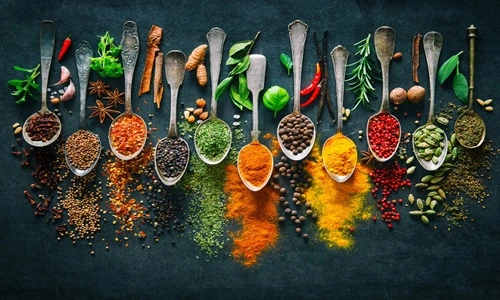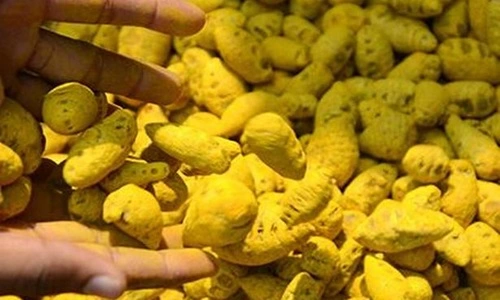India is known as “the spice bowl of the world” or the “spice capital” due to its wide variety of spices that have conquered the world one palate at a time. India’s landscapes are perfect for the growth of many naturally precious spices that are cherished and valued for their culinary importance and perceived medical effects. But there are some states known as the engine of large spice production in India, and their appeal trades globally. In this text, we will discuss India’s five largest spice-producing states and find out why they are famously known as the ‘spice hubs’ of the nation.

1. Madhya Pradesh:
Standing central to India, Madhya Pradesh is a divine producer that spreads various spices through many lands. It is already known that these spices, which include coriander, cumin, turmeric, and fenugreek, are cultivated most in the state. Neemuch, Ratlam, and Mandsaur districts are major spice producers and are well known as the spice-growing centers of the state.
2. Rajasthan:
Having been issued with a drought-affected dry climate and rugged terrain, Rajasthan breaks this myth to be the leading spice-producing state in India. The state is known for various spices, such as mace, clove, peppercorn, and cinnamon. Districts like Janta, Bana, and Nagaur of Rajasthan produce the best quality. The farmers from Rajasthan are facing some difficulties due to water scarcity and extreme climate conditions, yet they have proven incredible patience and creativity regarding increasing spice production.
3. Gujarat:
Among all other crops, Gujarat, which covers a great portion of the agricultural environment here, contributes the highest spice production at the national level. The state of this reputation is based on farming some of the highly esteemed spices, like chilies, fenugreek, and cumin, among the spices required in each list. The spice belt comprising Junagadh, Banaskatha, and Suratilles constitutes a substantial part of the total Gujarat spice trade. Its uniform agricultural policy, the persistent goal of research and farming, and the sector’s predominant position in organic farming make it a strong force, both at the home and international spice market access.
4. Andhra Pradesh:
Andhra Pradesh, with its name familiar in southern spices, boasts the widest variety of spices and sizable cultivation lands. The state gives a wide range of spices, such as red chili, turmeric, and black pepper, a perfect agro-climate; hence, they flourish. These regions, such as Guntur, Kurnool, and Prakasam, are the spice hubs of Andhra Pradesh and produce a quality spice in this state. Through advanced production technologies, government support, and infrastructure, the state’s vision allows for an affordable and efficient way of producing and distributing spices.
5. Telangana:
Shaped out of Andhra Pradesh in 2014, Telangana demonstrates that it is one of the main contributors to spice farming, adapting to the legacies of the parent state’s agriculture. The region uses its crop varieties of red pepper, turmeric, and coriander. The districts that were renowned for their spice production in the past, like Warangal, Khammam, and Nizamabad in modern-day Telangana. The creation of farmer welfare infrastructures, such as market linkages of farmer organizations and technology adoption, supports sustainable spice production. This, in turn, leads to the economic growth of the state.
Conclusion:
India’s top five largest spice-state-producing states -Madhya Pradesh, Rajasthan, Gujrat, Andhra Pradesh, and Telangana – indicate India’s uniqueness and on-pre-redundancy in producing spices. These states that strategically exploit their inimitable agro-climatic features, innovative agricultural approaches, and state assistance have successfully stimulated the rise of spice yields sustainably. As India remains the top global spice supplier, these states are considered crucial players in domestic processing and supplying international markets. Nevertheless, coordinated actions would need to be taken to solve issues like the negative effects of climate change, global fluctuations in the crop markets, and sustainable agricultural technologies for the spice industry to thrive in the future.
FAQs:
Q1. What spices are usually grown in these states, especially coffee and pepper?
Ans: Speaking of which, these nations are known for this and grow the finest types of spices, including cumin, coriander, turmeric, red chili, fenugreek, and, of course, black pepper.
Q2. What changes will climate change result in for spice cultivation in these areas?
Ans: Climate change can influence the conditions for seasonings by changing the amount of precipitation, increasing the extent of temperature highs or lows, and spreading pests and infections. Hence, adaptation strategies need to be developed.
Q3. Which quality and safety standards are in place to ensure the feasibility of using the ingredient?
Ans: The regulatory bodies and industry associations apply strict quality control measures, safety standards, and certification processes as self-regulating forces to ensure that Indian spices are marketed domestically and internationally.
Related Topics
- Top 5 Turmeric Producing States In India
- Top 5 Ginger Producing States In India
- Top 5 Chilli Producing States in India
- Top 5 Mustard Producing States In India
- Top 5 Cardamom Producing States In India

